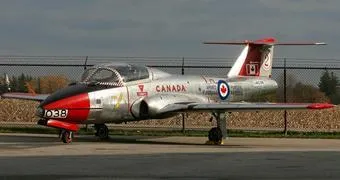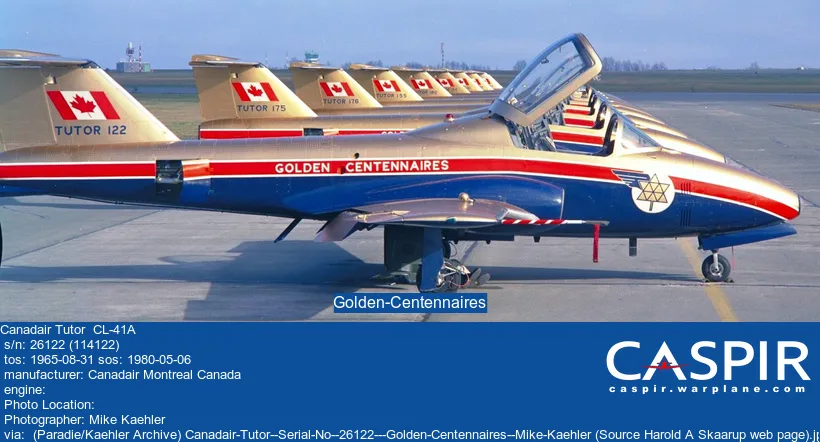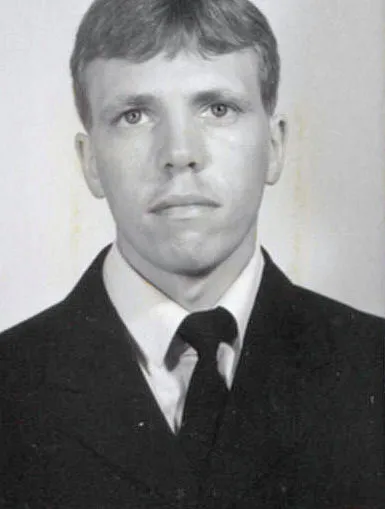Canadair CT-114 Tutor

The Canadair CT-114 Tutor (company model CL-41) was the Royal Canadian Air Force (RCAF), and later Canadian Forces, standard jet trainer between the early 1960s and 2000. It was designed and produced by Canadian aircraft manufacturer Canadair.
Development commenced as a private venture by the company. On 13 January 1960, the prototype performed its maiden flight; a year and a half later, the Canadian Government placed a major order for the type. The RCAF would be the dominant user of the type, but a limited number were exported as well. Specifically, the CL-41G model, which was supplied to the Royal Malaysian Air Force (RMAF), served as a ground-attack aircraft up until its withdrawal.
The Tutor served as the Canadian Forces primary jet trainer from the 1960s up until 2000, at which point it was finally retired from this role, having been replaced by a combination of the newer British-built CT-155 Hawk and American-built CT-156 Harvard II. While the majority of Tutors have been retired, a small handful of aircraft are currently still being used by the RCAF's Snowbirds aerobatics team.
The beginnings of the CL-41 Tutor can be found in a decision by Canadian aircraft manufacturer Canadair to develop its own indigenous trainer aircraft as a private venture. The design itself was the product of the company's in-house Preliminary Design department. By August 1957, the basic configuration of the design had been completed, which was of a turbojet-powered, low-wing aircraft, complete with a tricycle undercarriage and a side-by-side cockpit arrangement. From the onset of development, the aircraft was intended to be a purpose-built trainer for providing elementary jet flight training, as well as additional training up to an advanced level.
The CT-114 Tutor is a single-engine turbojet-powered trainer aircraft. It was purpose-designed for the training role, and possesses numerous favourable qualities, including a high level of reliability and favourable operating economics. It is capable of a wide performance range, possessing a top speed at altitude of 795 kmh (429 kt) and a diving speed of 885 kmh (478 kt) against a relatively low stalling speed of 71kt. The Tutor is furnished with manual flight controls, which incorporate spring tabs. It is intentionally aerodynamically stable in flight, a factor which traditionally has aided in the training of fresh pilots unfamiliar with the demands of flight.
The Tutor features a side-by-side cockpit. During standard operations, the observing instructor was seated on the right-hand side and the flying student pilot on the left; normally, only the left-hand side normally featured full flight controls. However, following experiences with the Snowbirds display team, a number of aircraft were reconfigured with extra controls so that they would be flyable from either position. The cabin, which is fitted with a rear-hinged canopy over both crew members, can be pressurized to a differential of 3 psi (20 kPa), the equivalent to an altitude of about 2,000 m, for pilot comfort.
For aerial display purposes, the Tutor was readily capable of being fitted with a smoke generator, including a pair of under-fuselage pods to house the pressurized diesel fuel used; the use of red dye in the smoke was discontinued fairly quickly as it was found to be highly corrosive. Various other modifications would also be made to display aircraft; these could be routinely installed and uninstalled as airframes would regularly be exchanged between display and training flights.
Aerobatics: During 1967, a batch of ten Tutors were modified for use as a formation aerobatic aircraft by the RCAF (and later the unified Canadian Forces) display team, the Golden Centennaires to celebrate Canada's centennial year. At the end of the 1967 season, the display team was disbanded, thus its aircraft returned to routine training duties. In 1971, a new formation team was formed at 2CFFTS (Two Canadian Forces Flying Training School) at CFB Moose Jaw, once again adopted the type. The following year, the name "Snowbirds" was chosen for the team; during 1978, the team received squadron status as 431 Air Demonstration Squadron.
Since its formation, the Snowbirds display team has regularly performed at air shows and special events, including the annual flypast on Canada Day over the capital city, Ottawa. According to journalist Guy Norris, a defining trait of their aerobatics is the physically-demanding formation flights performed, as well locally-developed manoeuvres such as the "Big Goose'. Unlike most display teams, the Snowbirds do not have a support aircraft; all spares and useful material could be carried by the aircraft themselves in storage areas located in the nose or the wing root.
Those Tutors used by the Snowbirds feature several modifications distinguishing them from standard examples; these include a smoke generating system, an highly-recognisable paint scheme unique to the display team, and a highly-tuned engine for greater responsiveness during low-level flying. Reportedly, display pilots would deliberately fly their aircraft using an above-average level of nose-down trim so that pushing the stick down would become unnecessary. The Snowbirds' aircraft would regularly be cycled with standard training aircraft, allowing the team to operate airframes with comparatively low accumulated flight hours. Wikipedia
 Wikipedia Canadair CT-114 Tutor
Wikipedia Canadair CT-114 Tutor
 CT-114 Tutor Kestrel Publications
CT-114 Tutor Kestrel Publications
CASPIR Aircraft Groups:
RCAF On Strength (191), Canadian Aircraft Losses (19)Tutor 26122
First delivered to 1 FTS in Gimli, MB. Transferred to 6 RD Det in Mountain View, ON as of 18 November 1966. Back to FIS Portage, MB as 9 September 1969. Flown by Golden Centennaires Aerobatic Team. Transferred to 2 CFFTS, CFB Moose Jaw,SK as of 8 June 1970. Was Snowbird #3 in initial Snowbird season, 1972. Was Snowbird #9 in 1973, 1974, 1975, and 1976 seasons. Crashed on 30 November 1979, near Ogema, SK. A student pilot was briefed and authorized to fly a solo clearhood mission in the local area. About fifteen minutes after takeoff the a/c was seen to make at least two passes over his aunt's farm. After the last pass, the pilot proceeded to his cousin's farm seven and a half miles away. As he flew by the farmhouse on his third pass, he began a left bank and the a/c continued to roll. The a/c struck the ground in a nose low inverted attitude, exploded and caught fire, killing the pilot. After arriving at his cousin's farm, the pilot did a pass near the house to get their attention. When he came back the second time he flew over the farm in a left bank. He then turned around to the west of the farmhouse and lined up for a pass by the south side of the farm at 250 ft AGL. As he went by the farmhouse he began another left bank. His cousin was in the yard waving to him. The investigation theorized that the pilot continued rolling to the left, presumably with his attention directed to something on the ground (target fixation). When he returned his attention to the a/c it was in an unusual nose low attitude. His actions were instinctive and according to the checklist; NOSE LOW UNUSUAL ATTITUDE - power to idle, speedbrakes out. He had only three and a half seconds from passing the house to the impact point. The a/c hit the ground, exploded and burned.The investigation concluded that the student's emotional state of over-confidence and desire to impress his relatives induced him to deliberately ignore rules and instructions and indulge in low flying manoeuvres beyond his capability.Kestrel Publications
1965-08-31 Taken on Strength 2021-12-26
1971-01-08 Serial Change Became CAF 114122 2019-08-20
1980-05-06 Struck off Strength Cat "A" write-off 2021-12-26





 Canadian Virtual War Memorial
Canadian Virtual War Memorial Hillcrest Cemetery, Canada
Hillcrest Cemetery, Canada Harold A Skaarup Web Page
Harold A Skaarup Web Page YouTube More than just the iconic Snowbirds demonstrator aircraft: the story of the Canadair CT-114 Tutor
YouTube More than just the iconic Snowbirds demonstrator aircraft: the story of the Canadair CT-114 Tutor